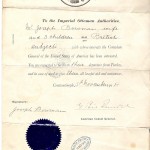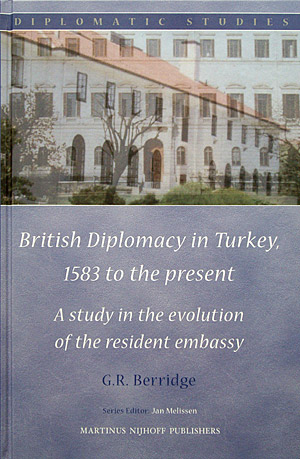British Diplomacy in Turkey, 1583 to the present: A study in the evolution of the resident embassy
(Martinus Nijhoff/Brill, Leiden 2009)
I regard this book, which took a huge amount of archival research, as possibly my most valuable contribution to the history of diplomacy. Unfortunately, it had a bad title. It is actually about the evolution of the British Embassy in Istanbul/Ankara and such general lessons as it might suggest about the role of embassies in general. But the title omitted to mention the embassy itself, while use of the notoriously loose term ‘Diplomacy’ in the main title compounded the deficiency by giving the impression that it was chiefly about British policy towards Turkey. The consequence was that it came to the attention mainly of Ottomanists (I still get invitations to speak in or about Turkey, four alone in 2022) and was almost completely ignored by historians of diplomacy – my own reference group and target. The front cover made matters worse. It shows the roof-line of the 20th century embassy building in Ankara half-superimposed on the front of the former embassy building (today consulate-general) in Istanbul. But who would spot this? In any case, it had little enough artistic merit. All of this was my fault.
Detail on the individual chapters of this work can now be found on the online edition page of the Brill website.
Addenda
Since publishing this book, a number of persons who served at the embassy but whom I overlooked or whose significance I failed fully to appreciate have either been kindly drawn to my attention or occurred to me independently. Therefore, as well as providing some general addenda, I add a little on these ‘missing persons’ below:
∙ Eustace Clare Grenville-Murray (1823-81), who was fifth paid attaché at the embassy in the mid-1850s, is perhaps my most glaring over-sight; so much so, in fact, that I have since written a full-length biography of him. See Diplomacy, Satire and the Victorians above.
• A military attaché at the High Commission in the first years after World War II was Captain Harold Courtenay Armstrong, later famous for his biography of Kemal Atatürk. First published in 1932 under the title Grey Wolf, Mustapha Kemal: An intimate study of a dictator, this was banned in Turkey, although, according to The Times (15 Apr. 1962), it was “much enjoyed by Atatürk himself, who had it translated”. It was later reported by the same newspaper to be the favourite book of the Egyptian leader, Gamal Abdul Nasser (5 Sept. 1970). The ODNB has no article on Armstrong but there is a useful obituary in The Times, 28 Aug. 1943. I am grateful to Sinan Kuneralp for drawing Armstrong’s association with the British diplomatic mission in Turkey to my attention.
• ‘R. Syme’, the assistant press attaché at Ankara whom I mention on pp. 195-6, was the Oxford scholar and famous Roman historian, Sir Ronald Syme (he was knighted in 1959). A brilliant linguist, according to the long essay on him in the ODNB he was “professor of classical philology in Istanbul” during WWII. “He did indeed teach classics; as to what other roles he played (as he certainly did),” the ODNB continues, “he never, to the end, gave the smallest hint”. Hmmm, well, that in itself seems a pretty big hint to me. I am grateful to Alan Henrikson for alerting me to Syme.
• The Marshall of the Supreme Consular Court at Constantinople, 1919-24, was Joseph Bowman. Like Capt. Armstrong (see above), he was invisible to me because he was not prominent at the time and served during the ‘High Commission’ period when staffing was irregular and the FO List incomplete. He was born in Thrislington, a poor mining community near Durham, on 12 March 1866, not 30 March 1865, as recorded in the FO List. Orphaned young, Bowman lied about his age in order to be accepted into the Royal Marines, and – the fabrication then being on record – presumably found it prudent to live with it thereafter. He spent the first half of his career with the Royal Marines, seeing active service during the Boxer rebellion, when he gained a reputation for being fearless and intrepid. He was then Constable at the British Legation at Peking from 1901 until 1905, when Sir Ernest Satow – an iconic figure to students of diplomacy – was minister. After a period in the Royal Fleet Reserve, he was employed as Second Messenger and Gaoler at the Constantinople Consulate-General during the four year prior to the outbreak of war with Turkey in November 1914, although he did not leave until 9 December.
H
Sources: FO List; Northern Echo, 7 Dec. 1900; Mrs Pamela Button.
• Makook III: On p. 171 I describe the stationnaire as the Embassy’s ‘de facto summer embassy’ (see also p. 129) and have since discovered several photos of it. One is on Wikimedia Commons here, although taken before it was acquired by the embassy.
• Embassy buildings: Some years after this book was published, Mark Bertram brought out a very important work on the history of Britain’s diplomatic buildings from 1800 until 2000 which I have reviewed here. This has much on Turkey, with excellent photos and diagrams, as has his current Catalogue of British embassy and consular buildings, 1800-2010, freely available here.
Reviews
The book was reviewed in Cornucopia, American Diplomacy, Diplomacy & Statecraft , and the Journal of the Royal Asiatic Society
From Cornucopia:
Do not be put off by the fact that this is one in the Diplomatic Studies series of “Clingendael”, the Netherlands Institute of International Relations. It is, of course, for the specialist, rather than the general reader: the famous organ, conveyed as Queen Elizabeth’s gift to the Sultan by the first Ambassador in 1583, gets no mention.
Geoff Berridge, Emeritus Professor of International Politics at Leicester University, best known for his Diplomacy – Theory and Practice, now in its 4th edition, is no newcomer to Turkish studies. He had already published both a fine biography as well as the correspondence of Gerald Fitzmaurice, the most renowned British dragoman of them all. He now casts his net much wider in this well-written and meticulous study.
The first three and a half centuries of British diplomacy in Turkey, up to the First World War, are dealt with in a hundred thematically-divided pages, before the 20th century (starting 1914 and lasting to 2008) is treated chronologically in another two hundred. This works well, except perhaps for disrupting in 1914 the story of The English Palace. The first purpose-built British embassy anywhere was burnt down in the great Pera fire of 1831 and eventually replaced by the splendid Barry building which has remained prominent in the concerns – and affection – of Ambassadors right through the move to the new capital at Ankara, the rebuild after the appalling suicide bombing in 2003 and reopening: well-fortified, more functional, less attractive. There remains room for a whole book on Pera House, which the British Treasury repeatedly advocated selling and then provided the huge sums required for rebuilding in 2003/04. Meanwhile, all ambassadors since at least 1945 must have heaved sighs of relief that the Therapia summer residence, of which the book has a handsome photo, burnt down in 1911. One palace is enough.
In its first years, furtherance of trade with the Levant was the Embassy’s raison d’être; the private Levant Company paid for and issued instructions to the Ambassador: and he doubtless took more heed of them than of those he had from the Government. The growing importance of the Ottoman Empire to the balance of power in Europe had, by the 19th century, transformed commercial agency into conventional diplomatic mission. The book’s nine appendices, interesting to those of us addicted to detail, include a list of consular posts in the Ottoman Empire in 1852: there were fifty, undertaking political, as well as commercial and consular, functions. Professor Berridge touches deftly on the succession of Envoys heading an embassy whose history, he maintains, was unusual and at times dramatic. He dubs Lord Stratford de Redcliffe “the most famous of all British ambassadors” – by implication to any country at any time.
20th century envoys are comparatively colourless: Sir Percy Lorraine was assured by the FO that it understood, on the eve of World War II, how he could not “make bricks without straw, or hold the fort without ammunition”. Pompous Percy, as his staff called him behind his back, famously caroused with Ataturk and handled astutely the latter’s wish for reconciliation with Britain. During World War II, Embassy numbers grew exponentially as military and intelligence officers of increasingly dubious hues were poured in by often-competing agencies. Despite his lamentable breaches of security, which gave his valet ‘Cicero’ the chance to steal top secret documents in 1943, Sir Hugh Knatchbull-Hugessen (“Snatch”) is given credit by Berridge for his judgement that Turkish neutrality, so vehemently challenged by Churchill, actually served British interests well.
Berridge has a soft spot for the Embassy’s put-upon dragomans, for Levantines and for the members of the Levant Consular Service of “natural-born Englishmen”. He is right to note the value of the Embassy’s locally-engaged staff as the old system changed, most dramatically after 1918, and London’s effort to ensure that at least some British diplomats speak Turkish to a useful standard. In that regard at least, the British are significantly ahead of all European and American competitors, although not of the Russians.
A large permanent embassy, now growing larger with Turkey’s growing political and commercial importance, Professor Berridge regards as essential to effective diplomacy. His conclusion, that “the recent history of the British Embassy in Turkey shows that resident diplomacy is alive and well and needs to be kept in this condition” is gratifying to a reader who spent nearly ten years in it. Timothy Daunt – H M Ambassador to Turkey 1986-9



